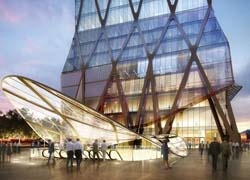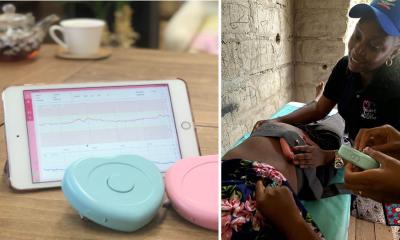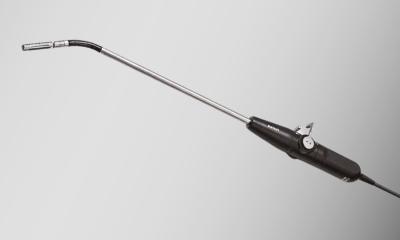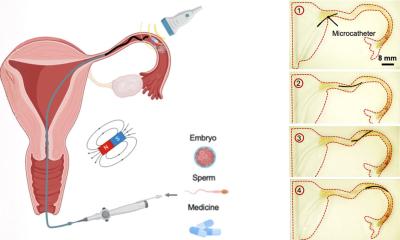A new high-rise on New York´s horizon
Ten years ago, New York real estate entrepreneur Israel Green began a worldwide search for a cure for his wife´s lung cancer. A year later, the couple returned to New York empty handed. Just days before a risky surgery, they were happily stunned to be given a very different diagnosis: acid reflux.

The implications of her documented history of a hiatus hernia, outlined in her novel-sized paper record, had gone unrecognised by the dozens of clinicians and specialists who reviewed her case and offered their expert opinions.
During their long and harrowing experience, an idea emerged: Healthcare providers and suppliers could benefit from a single destination offering access to the latest in healthcare education and products. Recognising an opportunity to improve information sharing and create connectivity and across healthcare, Israel Green set off to build a permanent global centre dedicated to healthcare. He believed that a single resource to unite healthcare could help bridge the many gaps he experienced. To that end he began looking for a development site near the Twin Tower to house this idea. Days away from closing on a development deal in Lower Manhattan, the terrorist attacks of 9/11 forced the project to be put on hold.
Two years ago, when he met Lee H Perlman, Chief Financial Officer and Senior Vice President of the Greater New York Hospital Association (GNYHA), and President of GNYHA Ventures, Inc, he found they harboured a similar dream and, last July, they created a partnership to again pursue the idea.
Architectural plans are complete and the centre’s 60-story 1.5 million square foot glass construction, by the Extell Development Corporation, should begin in 2010, on the already cleared former site of the CopaCobana club at Manhattan’s Eleventh and W 34th Street. In 2013, all being well, the doors of the World Product Centre will open to the world.
During the RSNA meeting in Chicago, Daniela Zimmermann met with Lee Perlman, as well as the President of World Product Centre John Strong, and Executive Vice President Michael Resnick, to find out more about this recession defying project.
Initially, Lee Perlman explained the need for a new way of buying and selling medical equipment, caused by the changing policies and practices in business. ‘People used to visit companies at their headquarters, and see demo sites at different installations in different hospitals. Now that is verboten. So, we need a new way of buying and selling that allows for neutrality and transparency – so people can shop in a safe haven. Our idea is to have a year-round destination that people will go to either to be educated, as a yearly sojourn, or to see what’s the latest and greatest. But, more importantly, for people to make specific visits to outfit a wing, or a hospital, and be able to do it so that great companies can sell great technology in an environment where nobody’s going to question it.
‘Every company with any sort of magnitude in the US sells internationally and any European company that has any substance sells in the US. Since these companies are international, let them align their view of the world on an international basis. In 1964, when the World’s Fair was held in New York, people came from all around the world. This is a World’s Fair for healthcare, where people can celebrate the internationalisation of healthcare, and not be embarrassed about selling their stuff. I expect that a significant number of the companies who end up at the Centre will be either international, or companies with real European footprints that don’t have a presence in the US and want to get in.’
Who will be the licensees?
The Centre could not accommodate all the medical manufacturers, Lee Perlman pointed out: a ‘critical mass’ is needed. ‘I’d be disappointed if this whole building didn’t have representatives from food, radiology, pharma and so on. But I don’t need every radiology company; I want a cross-section.’
‘We aren’t only talking to the big medical equipment suppliers, but also to companies and healthcare providers who provide medical training; medical insurers, and to finance firms who lease equipment or facilities to hospitals,’ said John Strong. ‘I was talking to an equipment planner for a US hospital who said: This is great -- we spend hundreds of thousands of dollars flying around to evaluate the latest technology, all over the world. This will bring it all into one building.
‘Seven people are calling on potential licensees right now,’ John Strong continued. ‘They include the former general manager of Swiss Ray, Hans Behrendt, who is doing our sales and marketing in Western and Central Europe.’ Consultants in the Pacific Rim are also meeting firms based there. ‘So far, we have talked to about 100 companies around the world, mostly at CEO level. The reception has been very strong. People are interested in the concept because it brings an opportunity to have very rigorous and serious educational conferences with the idea of displaying your latest technology, and the technology infrastructure in the building allows companies to bring in, from virtually anywhere in the world, operating procedures that are going on live, or other clinical procedures being conducted in hospitals. So, if you are in your show space and you want to talk to a group of American physicians and they can see the equipment that you are talking about, they can actually see a procedure being done, let’s say in London. The building is very high tech in that regard.
‘This is really a new way of looking at selling medical equipment and medical devices, but as companies come in, we’ve already had others say, well, if my competitor is going to be there, I need to be there. We’ve only been marketing this publicly for about 60 days, and are already close to some formal commitments.’
Education at the World Product Centre
World Product Centre has plans to offer a year round calendar of healthcare events and continuing medical and professional education. To support these activities, the Centre will contain a 500-seat auditorium and an educational centre that can accommodate up to several thousand attendees. The Centre also is reviewing plans for a surgical training centre as well as a state-of-the-art simulation centre for training medical personnel. Hewlett Packard has also begun preliminary plans to build a healthcare technology showcase and training centre with a network backbone supporting device and technology connectivity and interoperability.
A $50 million non-profit World Product Centre Foundation is to be formed for educational programmes. ‘This will not be US-centric,’ said Michael Resnick. ‘We are currently looking in Europe and in Asia for members of our medical advisory board, to have an international presence and international perspective. We are also soliciting advice from physicians in the medical community on matters of commerce. At the same time, we plan to focus a good deal of the education and training in the first few years around attracting attendees from the north-eastern United States. The local market of providers and healthcare facilities is one of the most concentrated in the world. 40% of all academic hospital beds in the United States are within a half days drive.’
Douglas Maynard MD, Chair of the World Product Centre Medical Advisory Board, said meetings would fall into four brackets – those put on by the licensed vendors, to train employees or clients; joint meetings for example held by manufacturers of CTs or MRIs, to draw in an audience particularly interested in that technology; unique international programmes put on by the Centre’s own education staff, and finally meetings held by individual medical societies. ‘The building can accommodate meetings for between 2,500 and 3,000 people. Lots of medical society meetings are that size, or smaller, so their annual meetings could be held there. Finally, we would get associations like the RSNA, Roentgen Ray, ACR, Merton College of Cardiology, or departments of orthopaedics or surgery and so on, to put on specialised meetings. So radiology might have four meetings a year but, every quarter, it could be surgery, neurosurgery, oncology, cardiology, neurology, intensive care, emergency medicine -- all the other major disciplines that would like to come to a place where they could also go around and meet the various vendors selling what they’re interested in.’
Walking to Wall Street
At the Centre, international healthcare companies would have their own offices, close to Wall Street. ‘Many companies are interested in being public, going public, trading on international markets – New York is the centrepiece of the financial markets. So, we’ll give them a way to talk to Wall Street,’ said Lee Perlman. ‘Additionally, each financial firm’s market analysts will also be able to directly view and analyse new technology, product announcements and earnings reports.’
Other exhibition organisers, such as for the RSNA or MEDICA, may also welcome involvement, if they want activities not only during their four-day events, but also during the rest of the year, he conjectured. ‘We’re looking for strategic partners, and want to do this with some infrastructure that exists, but at the same time, we want people to recognise that the model for selling is changing, and if they aren’t open to changing a little, they’re going to miss an opportunity, because public policy around the world is dictating a new way of selling.’
At the Centre, no two days will be the same, Perlman added. ‘We’ll have designated areas to enable frequent rotation. Nothing will be stagnant. We’ll do everything to keep new companies and new blood in there and make it a place of innovation. So, we are also absolutely dedicated to having a vehicle for incubator companies, otherwise the centre would die, because we’d only rely upon our existing companies for new innovation. We’re going to talk to venture capitalists that develop start-up companies.’
‘This Centre is no small task. Healthcare is so expansive that, to make it work, the building has to be big; the aspiration has to be big; the number of companies has to be big. Then, when it becomes a successful model for commerce, it probably should be duplicated around the world.’
Financing
Up to 2010, the project will be privately financed by Israel Green and the Extell Development Corporation. However, to commence construction, Michael Resnick explained that bank finance will be needed; the collateral for this will be multi-year financial commitments by participating companies. There are a lot of factors, such as private equity interest, and the liquidity of the financial markets.’ However, he said, Extell and the developers have a good deal of experience in securing capital.
The financial crisis, said John Strong, has made companies ‘a bit more cautious in terms of their expenditures’. However, he has found enough interest in the building to suggest they are planning ahead – the centre will open in five years.
World Product Centre IT
$85 million has been allocated for the building’s IT.
Five years ago, Hewlett Packard was contracted to design, implement and maintain the Centre’s IT, and support that of the vendors. HP will also update the IT after three and then again in seven years. ‘HP will be the technology integrator at World Product Centre and has committed to a vendor neutral IT environment leveraging best-in-breed technology.’ The technology infrastructure will also provide business and communication technology including digital translation capabiliites in six basic languages.
Building management
The building and land will be owned and managed by Extell Development Company. The World Product Centre itself ‘will be responsible for its own management and operations, soup to nuts,’ John Strong explained. ‘There are lots of different components – facilities, education, technology operations, and so on’ Education sponsored by the Centre will be self managed, ‘to maintain the independence and integrity of the education provided.’
But, really, why New York?
European consultants have been in contact with Siemens, Toshiba, Philips, and GE for years, and know precisely what is going on, Daniela Zimmerman pointed out. Surely they have no reason to fly to New York to decide on an MR machine?’
Michael Resnick picked up the thread. ‘The centre is a single location, convenient for any buyer, a hospital CEO, distributor, doctor, who needs to make a purchasing decision for one product or lots of products. Say you are building a new hospital and want to buy a new MRI machine, or you just want to see the latest technology, you can come here at your convenience to compare products and services. You bring a team to New York for a week and go through the building, meet all the vendors, look at all of the products. Why? Because it’s convenient at the time you’re building the hospital. You don’t have to wait until RSNA, and you don’t have to go to each company. They will all be under one roof. It’s a new way of selling, and World Product Centre is independent and there’s no problem with transparency.’
As for fears of proximity with competitors, John Strong said only one company has expressed concern. Indeed, many want them in the same general area, because they know ‘there’s always comparison-shopping’ and they benefit from the traffic generated by a centralised resource.
Michael Resnick referenced the potentially high cost of RSNA exhibition space, ‘at some point I imagine companies doing a cost benefit analysis to determine the true value of exhibiting. Additionally, I have heard concerns in speaking with exhibitors about the number of C-suite executives and decision makers in attendance.’
However, difficulties for companies caused by cultural, language and health service differences in Europe cannot be denied. How could one centre, on the USA’s eastern seaboard, solve such problems at a stroke, and how could they be sure Europeans would travel there?
Many groups of physicians, hospital administrators, policymakers and so on, already come from all over the world to tour US hospitals and learn from them, he argued. In addition, New York has a high concentration of top physicians, medical schools, medical centres, hospitals and medical schools, making up an enormous built-in audience, in close proximity. ‘I see companies of all types using WPC to penetrate the local market, expand their east coast presence as well as international companies using World Product Centre to create visibility in the US market and bring international visitors for specific types of visits.
Medical technology firms, he said, could set up their reference centres there, as they do in their own headquarters. ‘It’s not just about having a showcase; it’s multidimensional. We’ll provide conference rooms, media centres, access to Wall Street and the advantage of all other resources that exist in New York for commerce.’
Handling international cost discrepancies
Daniela Zimmermann then brought up a critical question: the variation in prices for equipment among European countries: ‘Germany is the best place to buy a CT at the moment. It costs less than in France. But, in Russia, it doubles,’ she pointed out, adding: ‘Italy is a specific market. How can you solve a problem in America that’s based in Italy? If they go to New York, they’ll still want to buy a CT for the price they’ve known all along. How would you overcome that?’
‘It will be an issue,’ Michael Resnick agreed. ‘But the individual vendors will deal with prices. But, we do have a similar phenomenon in the United States. When somebody goes to buy medical equipment and devices, they more than likely have a GPO affiliation, with a unique contracted price.’
In the US, when debating which company’s latest CT scanner to buy, added John Strong, the healthcare system involved generally will evaluate multiple systems, regardless of price. ‘That’s part of what’s wrong with our system.’ The question of whether more expensive technology is needed, or whether the same procedure could be performed with less costly equipment for the same patient outcome, should be asked, he said.
‘From a global healthcare perspective,’ Michael Resnick added, ‘the impact that World Product Centre can have is very positive. It will create greater information sharing, which we believe will lead to better decisions, which will lead to better health outcomes.’
Glancing around at the RSNA exhibition, Michael Resnick pointed out that many foreign nationals were visiting stands. ‘I don’t think the exhibitors are concerned about showcasing at RSNA because the Russians will find out that it’s cheaper to buy the same product somewhere else.’
‘If we think about the magnitude of the healthcare issues that we face in the United States, it puts this current economic crisis thing into perspective. Total spending was $2.4 TRILLION in 2007, 17% of GDP with a projected annual inflation rate to be close to 7% in 2009. Plus we have over 45 million uninsured Americans,’ Michael Resnick reflected. ‘We are looking at solutions and we think the Centre can provide one potential strategy. Connectivity and interoperability around healthcare information, technology, devices and information is becoming a reality. As a permanent and highly visible platform, the Centre can be a showcase and testing site for many of the new ideas and technologies. So, I think we’ve caught it at a good time.
27.03.2009









